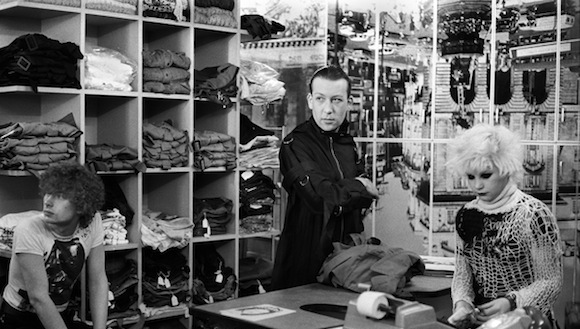The first two paragraphs from Bee Wilson’s London Review of Books piece about the new autobiography by Vivienne Westwood, the designer who made punk a big thing but lost interest when she realized her tattered tees were a fashion statement but not a political one:
“Some time in 1979, after the death of Sid Vicious and before the enthronement of Margaret Thatcher, Vivienne Westwood ‘lost interest’ in punk. She and her lover Malcolm McLaren had been at the heart of the British version: they had dreamed up much of the look, the attitude and the lyrics, though not the sound. A full year before David Bowie adopted the same hair style, Westwood had her hair bleached blonde and cut ‘coupe-sauvage’ style: tufty, asymmetrical and barmy-looking. She went to America and dressed the New York Dolls. Together, she and McLaren assembled the Sex Pistols, whom they got to know thanks to SEX, the clothes shop they (McLaren and Westwood) ran on the King’s Road. There is fierce disagreement as to whether Westwood or John Lydon, a.k.a. Johnny Rotten, thought up the title ‘Anarchy in the UK’ – he says it was him; she says it was her – but there is no doubt that she had a powerful influence on the way punks, including Lydon, dressed. She was the first to design T-shirts covered in punk ‘bricolage’, ranging from studs and chains to chicken bones to nipple zips, and she was the one who put a safety pin through the queen’s mouth on a T-shirt. By 1977, teenagers all over the country were copying the look she had started: the spiky hair, the studs, the clothes daubed with antisocial messages. It wasn’t what Westwood had wanted, though. She was hoping for revolution. ‘When I turned round, on the barricades,’ she says in Vivienne Westwood, an autobiography written with Ian Kelly (rather than the usual ghostwritten celebrity tosh), ‘there was no one there. That was how it felt. They were just still pogoing. So I lost interest.’
The prevailing impression of Westwood that we get from the book is of a leader whose people have been a constant disappointment to her. ‘The way I thought about ‘punk’ politics,’ Westwood says now, ‘was this: at the time, we were just becoming aware of these terrible politicians torturing people – I’m thinking of Pinochet, for instance … The idea was that kids would try to put a spoke in the wheel of this terrible killing machine.’ She saw herself as someone who would ‘confront the rotten status quo through the way I dressed and dressed others’. But it turned out that the kids were mainly interested in buying the new rubber skirts and bondage gear from her shop and playing punk rock records. Whoever deserves the credit for the title ‘Anarchy in the UK,’ the people listening to the music were not taking the message seriously enough. Few punks got the connection – so obvious to Westwood – between wearing a distressed top featuring a swastika, the word DESTROY and defeating Pinochet. Westwood believed her clothes – which she saw and still sees as her art – were inexorably leading punks towards radical politics. When you put on a punk garment such as a real dog collar, Westwood says, ‘basically you are insulting yourself, but you’re also clearing yourself of all egotism.’ But when she turned round, they were just spitting and jumping. So she moved on.”
Tags: Bee Wilson, Vivienne Westwood

